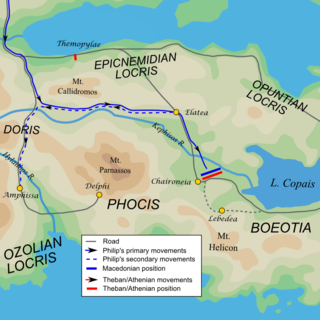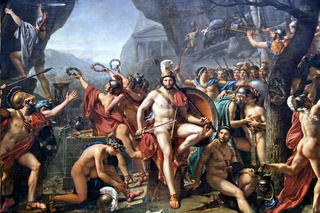Related Research Articles
Year 241 BC was a year of the pre-Julian Roman calendar. At the time it was known as the Year of the Consulship of Atticus and Cerco. The denomination 241 BC for this year has been used since the early medieval period, when the Anno Domini calendar era became the prevalent method in Europe for naming years.
Year 228 BC was a year of the pre-Julian Roman calendar. At the time it was known as the Year of the Consulship of Ruga and Verrucosus. The denomination 228 BC for this year has been used since the early medieval period, when the Anno Domini calendar era became the prevalent method in Europe for naming years.

Year 338 BC was a year of the pre-Julian Roman calendar. At the time it was known as the Year of the Consulship of Camillus and Maenius. The denomination 338 BC for this year has been used since the early medieval period, when the Anno Domini calendar era became the prevalent method in Europe for naming years.
Pleistoanax, also spelled Plistoanax, was Agiad king of Sparta from 458 to 409 BC. He was the leader of the peace party in Sparta at a time of violent confrontations against Athens for the hegemony over Greece.
Leotychidas II was king of Sparta between 491–476 BC, alongside Cleomenes I and later Leonidas I and Pleistarchus. He led Spartan forces during the Persian Wars from 490 BC to 478 BC.
Agis III was the eldest son of Archidamus III, and the 21st Eurypontid king of Sparta between 338 and 331 BC. He tried to lead a revolt against Macedonian hegemony over Greece, but was defeated by Antipater—Alexander the Great's regent in Greece—at the Battle of Megalopolis in 331 BC, where he died.

Agis IV, the elder son of Eudamidas II, was the 25th king of the Eurypontid dynasty of Sparta. Posterity has reckoned him an idealistic but impractical monarch.
Cleomenes II was king of Sparta from 370 to 309 BC. He was the second son of Cleombrotus I, and grandfather of Areus I, who succeeded him. Although he reigned for more than 60 years, his life is completely unknown, apart from a victory at the Pythian Games in 336 BC. Several theories have been suggested by modern historians to explain such inactivity, but none has gained consensus.

Leonidas II was the 28th Agiad King of Sparta from 254 to 242 BC and from 241 to 235 BC.
Archidamus I, also spelled ArchidamosI, was a king of Sparta, 12th of the Eurypontids. He reigned from c. 660 to c. 645.
Anaxidamus was a king of Sparta, 11th of the Eurypontids.
Eucleidas reigned Sparta from 227 BC to 222 BC. He was an Agiad, son of Leonidas II, in the place of the Eurypontid king.
Archidamus V was the 27th of the Kings of Sparta of the Eurypontid line, reigning during 228 and 227 BC.
Archidamus IV was Eurypontid king of Sparta from c. 300 BC to c. 275 BC. An obscure king, Archidamus is only known for his defeat against the Macedonian king Demetrius Poliorketes at Mantinea in 294, where he might have also died since nothing is heard of him afterwards. This defeat marks the beginning of a long eclipse for the Eurypontid kings, who are not mentioned again until the emergence of Agis IV 50 years later.
Eudamidas I was Spartan king between 331 and c. 300 BC. He succeeded his brother Agis III, who died at the battle of Megalopolis against Macedonia. Eudamidas' reign was therefore peaceful as Sparta recovered from this disaster. He even refused to join the other Greek states in the Lamian War in 323, and was later noted for his interest in philosophy—peculiar for a Spartan king.
Theopompus was a Eurypontid king of Sparta. He is believed to have reigned during the late 8th and early 7th century BC.

The Agiad dynasty was one of the two royal families of the Ancient Greek city-state of Sparta. They ruled jointly along with the Eurypontid dynasty, possibly from the 8th century BC onwards, being the senior of the two houses. The hypothetical founder of the dynasty was Agis I, possibly the first king of Sparta at the end of the 10th century BC, who subsequently gave his name to the dynasty. The two lines, who maintained an enduring rivalry, were, according to tradition, respectively descended from the twins Eurysthenes and Procles, both descendants of Heracles. The most famous member of the Agiad dynasty was Leonidas I, known for his heroic death at the Battle of Thermopylae in 480 BC. The last Agiad king was Agesipolis III, deposed by the Eurypontid Lycurgus in 215 BC.
Eudamidas III, son of Agis IV and Agiatis, daughter of Gylippus, was king of Sparta and a member of the Eurypontid dynasty. When his father was murdered he had just been born. Due to his minor age he never reigned and was succeeded by his uncle Archidamus V.

Pausanias was the Agiad King of Sparta; the son of Pleistoanax. He ruled Sparta from 445 BC to 427 BC and again from 409 BC to 395 BC. He was the leader of the faction in Sparta that opposed the imperialist policy conducted by Lysander.
Agesistrata, was a Spartan queen, married to king Eudamidas II of Sparta.
References
- ↑ McQueen, E. I. (1990). "The Eurypontid House in Hellenistic Sparta". Historia: Zeitschrift für Alte Geschichte. 39 (2): 163–181. ISSN 0018-2311. JSTOR 4436145.
- ↑ Hodkinson, Stephen (December 1986). "Land tenure and Inheritance in Classical Sparta". The Classical Quarterly. 36 (2): 378–406. doi:10.1017/S0009838800012143. ISSN 0009-8388.
